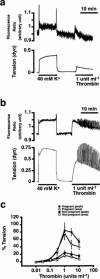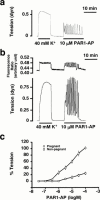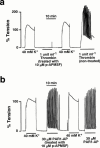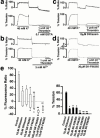Enhanced contractile response to thrombin in the pregnant rat myometrium
- PMID: 11139439
- PMCID: PMC1572489
- DOI: 10.1038/sj.bjp.0703729
Enhanced contractile response to thrombin in the pregnant rat myometrium
Abstract
Thrombin causes various cellular events by activating protease-activated receptors (PARs). Here, we showed, for the first time, that thrombin induced myometrial contraction. To determine the mechanism of thrombin-induced myometrial contraction, we simultaneously measured intracellular Ca(2+) concentration ([Ca(2+)](i)) and tension of fura-PE3-loaded rat myometrium using front-surface fluorimetry. The expression of thrombin receptor mRNA in the rat myometrium were determined by reverse transcription-polymerase chain reaction analysis (RT - PCR analysis). Thrombin (0.01 - 3 u ml(-1)) caused dose-dependent increase in [Ca(2+)](i) and tension in the rat myometrium, and this effect was greatly enhanced in the pregnant myometrium. PAR1-activating peptide mimicked the effects of thrombin. In Ca(2+)-free PSS, thrombin induced no increase in [Ca(2+)](i) and tension in the pregnant myometrium. Both diltiazem (10 microM) and SK-F 96365 (10 microM) significantly inhibited the thrombin-induced elevations of [Ca(2+)](i) and tension, and their effects were additive. RT - PCR analysis revealed an approximately 10 fold increase in the level of thrombin receptor mRNA in the pregnant myometrium compared to that obtained in the non-pregnant myometrium. In conclusion, the contractile response to thrombin was greatly enhanced in the pregnant myometrium, mainly due to the up-regulation of thrombin receptor. We propose that initiation of a post-parturitional myometrial contraction is one of the most important physiological roles of thrombin receptor.
Figures






Similar articles
-
Enhancement of trypsin-induced contraction by in vivo treatment with 17beta-estradiol and progesterone in rat myometrium.Br J Pharmacol. 2005 Oct;146(3):425-34. doi: 10.1038/sj.bjp.0706345. Br J Pharmacol. 2005. PMID: 16056237 Free PMC article.
-
Mechanism of trypsin-induced contraction in the rat myometrium: the possible involvement of a novel member of protease-activated receptor.Br J Pharmacol. 2001 Aug;133(8):1276-85. doi: 10.1038/sj.bjp.0704206. Br J Pharmacol. 2001. PMID: 11498513 Free PMC article.
-
Mechanisms of galanin-induced contraction in the rat myometrium.Br J Pharmacol. 1998 Aug;124(8):1623-32. doi: 10.1038/sj.bjp.0702004. Br J Pharmacol. 1998. PMID: 9756377 Free PMC article.
-
Mechanisms underlying the neurokinin A-induced contraction of the pregnant rat myometrium.Br J Pharmacol. 2000 Jul;130(5):1165-73. doi: 10.1038/sj.bjp.0703410. Br J Pharmacol. 2000. PMID: 10882403 Free PMC article.
-
Pharmacological techniques for the in vitro study of the uterus.J Pharmacol Toxicol Methods. 2001 Mar-Apr;45(2):123-40. doi: 10.1016/s1056-8719(01)00143-5. J Pharmacol Toxicol Methods. 2001. PMID: 11687380 Review. No abstract available.
Cited by
-
Unproductive cleavage and the inactivation of protease-activated receptor-1 by trypsin in vascular endothelial cells.Br J Pharmacol. 2003 Jan;138(1):121-30. doi: 10.1038/sj.bjp.0705008. Br J Pharmacol. 2003. PMID: 12522081 Free PMC article.
-
Enhancement of trypsin-induced contraction by in vivo treatment with 17beta-estradiol and progesterone in rat myometrium.Br J Pharmacol. 2005 Oct;146(3):425-34. doi: 10.1038/sj.bjp.0706345. Br J Pharmacol. 2005. PMID: 16056237 Free PMC article.
-
Matrix Metalloprotease-1 and Elastase Are Novel Uterotonic Agents Acting Through Protease-Activated Receptor 1.Reprod Sci. 2018 Jul;25(7):1058-1066. doi: 10.1177/1933719117732162. Epub 2017 Sep 27. Reprod Sci. 2018. PMID: 28954603 Free PMC article.
-
Changes in amniotic fluid concentration of thrombin-antithrombin III complexes in patients with preterm labor: evidence of an increased thrombin generation.J Matern Fetal Neonatal Med. 2009 Nov;22(11):971-82. doi: 10.3109/14767050902994762. J Matern Fetal Neonatal Med. 2009. PMID: 19900035 Free PMC article.
-
Changes in global gene expression in rat myometrium in transition from late pregnancy to parturition.Physiol Genomics. 2009 Jan 8;36(2):89-97. doi: 10.1152/physiolgenomics.00290.2007. Epub 2008 Nov 11. Physiol Genomics. 2009. PMID: 19001510 Free PMC article.
References
-
- BLACKHART B.D., EMILSSON K., NGUYEN D., TENG W., MARTELLI A.J., NYSTEDT S., SUNDELIN J., SCARBOROUGH R.M. Ligand cross-reactivity within the protease-activated receptor family. J. Biol. Chem. 1996;271:16466–16471. - PubMed
-
- BRETSCHNEIDER E., PAINTZ M., GLUSA E. Inositol, 1,4,5-triphosphate and protein kinase C are involved in thrombin- and trap-induced vascular smooth muscle contraction. Agents Actions (Suppl.) 1995;45:309–313. - PubMed
-
- BUHL A.M., JOHNSON N.L., DHANASEKARAN N., JOHNSON G.L. G alpha 12 and G alpha 13 stimulate Rho-dependent stress fiber formation and focal adhesion assembly. J. Biol. Chem. 1995;270:24631–24634. - PubMed
-
- CHAIB N., KABRE E., METIOUI M., ALZOLA E., DANTINNE C., MARINO A., DEHAYE J.P. Differential sensitivity to nickel and SK&F96365 of second messenger-operated and receptor-operated calcium channels in rat submandibular ductal cells. Cell Calcium. 1998;23:395–404. - PubMed
Publication types
MeSH terms
Substances
LinkOut - more resources
Full Text Sources
Miscellaneous

